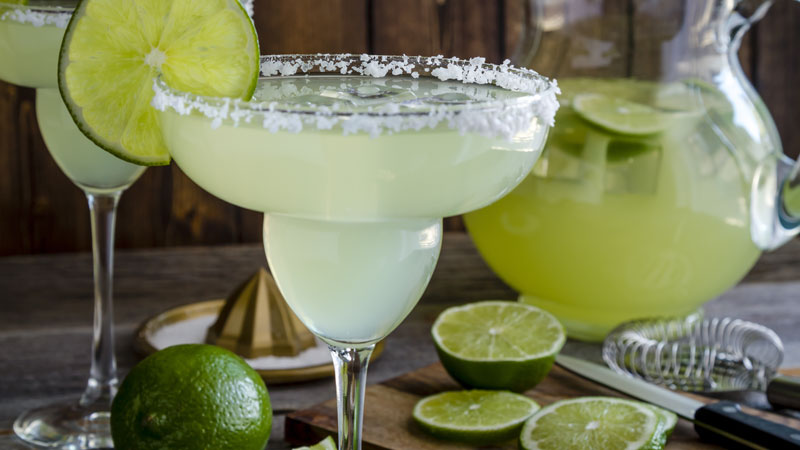Ask 10 people of legal drinking age if they like Margaritas, and expect to get a shiny dime in return.
Margaritas have been the most popular cocktail in the U.S. for two consecutive years, according to Nielsen data. Tequila sales across the United States are up 9.9 percent. And the 1971 invention of frozen Margs most certainly laid the groundwork for today’s Frosé and Pinot Freezio; it also transformed a fledgling Texas family dining restaurant, Chili’s, into a national chain raking in $3.42 billion a year.
A classic Margarita requires just three ingredients: tequila, lime juice, and triple sec. The simplicity of that rubric leaves little room for error, yet ample space for innovation. Thus, the proliferation of alternatively strange and sublime Margarita variations in prepackaged mixers or creative bars.
The key to making praise-worthy Margaritas at home is attention to detail.
“As a three-ingredient cocktail, each component plays a central role,” Jim Kearns, bar director and managing partner, The Happiest Hour and Slowly Shirley in NYC, says. “With so few ingredients, any attempt to cut corners will stand out.”
We asked Kearns and other bartenders across the country for their tips. Here are six dos and don’ts for mastering Margaritas.
What To Do When Making Margaritas
1. Juice Your Own Limes.
We spoke to seven bartenders about making great Margaritas, and every one stressed the importance of freshly squeezed lime juice.
“I’d much rather drink a Margarita made with cheap tequila and fresh lime juice, than one made with premium liquor and store-bought sour mix,” Aren Bellendo, lead bartender at SideDoor and Lawry’s in Chicago, says.
Pre-made mixes and bottled juices have varying amounts of sugar that will throw off your cocktail’s sweet-sour balance. Stick with natural ingredients like homemade juice, however, and you will know exactly how much sweetness you need to add to offset the tart citrus.
2. Use the Best Tequila You Can Afford.
You might have a cheap bottle of tequila lying around, or see one on triple-markdown at your local package store. It’s tempting to throw that into a cocktail and hope that the other ingredients will hide its flaws.
Resist this urge. Because there are so few components in a Margarita, each one matters. If you use low-quality tequila with off flavors or a boozy aftertaste, your cocktail will have those exact same flaws.
“Only 100 percent Weber blue agave tequila should be used, ever, for anything,” Kearns says. His favorite tequilas for making Margaritas include Siete Leguas, Siembra Azul, Cabeza, and Pueblo Viejo Blanco. We also like Casa Noble Crystal and these six others.
(If you don’t have the time or budget for a new bottle of tequila, remember the previous tip about the merit of freshly squeezed limes. Whole fruit is typically less expensive than prepared juices or mixers, too.)
3. Know Your Ratios.
One common Margarita mistake is over-sweetening the cocktail, according to Kenneth McCoy, chief creative officer of Public House Collective, a hospitality group in NYC. “You want the lime to come through and have a subtle bite to it, not to feel like you are drinking a Slurpee from 7-Eleven,” he says.
The best way to make a perfectly sweet-sour Margarita is to know your ratios.
“The ratios are everything,” Amanda Swanson, agave sommelier at Añejo in NYC, says. “From there you can adjust to your own personal taste.”
Our classic Margarita recipe calls for 1 ¾ parts tequila to 1 part lime juice to ¾ part orange liqueur. If you prefer a sweeter drink, swap out half the liqueur for agave nectar. Still too tart? Continue adding agave and reducing other ingredients until you’ve hit your perfect balance.
Bartenders often prefer agave nectar over simple syrup for this purpose, saying it provides a smoother, subtler sweetness.
4. Orange You Glad You Bought Liqueur?
The easiest ingredient to overlook is the orange liqueur. Triple sec seems like a weird thing to buy for just one cocktail, right? Can’t you just add a splash of orange juice or something?
Not if you want a well-balanced drink. Triple sec, a term used interchangeably with curaçao, is a type of orange liqueur that provides fruity flavors as well as sweet and bitter notes — all of which are essential for a well-made Margarita. Popular labels include Cointreau, Combier, Pierre Ferrand Curaçao, and Grand Marnier.
Swanson likes to use Cointreau in her Margaritas because it’s made with bitter orange peels, so she finds it “drier than many brands of triple sec, and considerably less sweet than brandy-based Grand Marnier,” she says.
Kearns opts for Cointreau or Combier, the 1834 orange liqueur that purports to be the world’s first triple sec. David Mor, beverage manager at Cindy’s in Chicago, prefers Pierre Ferrand Dry Curaçao in his Margaritas.
“The most important thing there is to avoid anything that is simply called ‘Triple Sec,’” Kearns says. “This was a marketing statement devised by Cointreau at one point in its long history, and knock-off brands latched onto it.” Consider yourself warned.

What to Avoid When Making Margaritas
1. Don’t Salt the Entire Rim.
Like your Margaritas with salt? Season away, but take care when rimming the glass. Excess flakes will inevitably fall into your cocktail, throwing off its flavors and balance.
Cocktailers like industry legend Dale DeGroff advise salting a segment of the glass rim instead of its entirety. It prevents your drink from ever getting too saline, and gives you the option of taking a sip with or without a mouthful of salt.
“Generally speaking, if we do a rim we do half a rim,” Don Lee, partner, Existing Conditions in NYC, says. “That way everyone has the option.” Make sure you are only salting the outside of the rim of the glass, too, Lee says.
2. Skip the Lime Garnish.
You probably have one or two extra limes lying around after making all that lovely fresh juice. Don’t slice them into wedges to use as garnishes, no matter how natural that seems.
Why? Because your drink is perfectly balanced at this point. By adding a lime wedge, you are inviting someone to squeeze it into their drink. That will “throw off the citric balance of the cocktail,” Mor says. Instead, he suggests expressing an orange peel on top, giving the drink a citrusy aroma without the threat of more acid. Margaritas, like most things in life, are all about balance.
